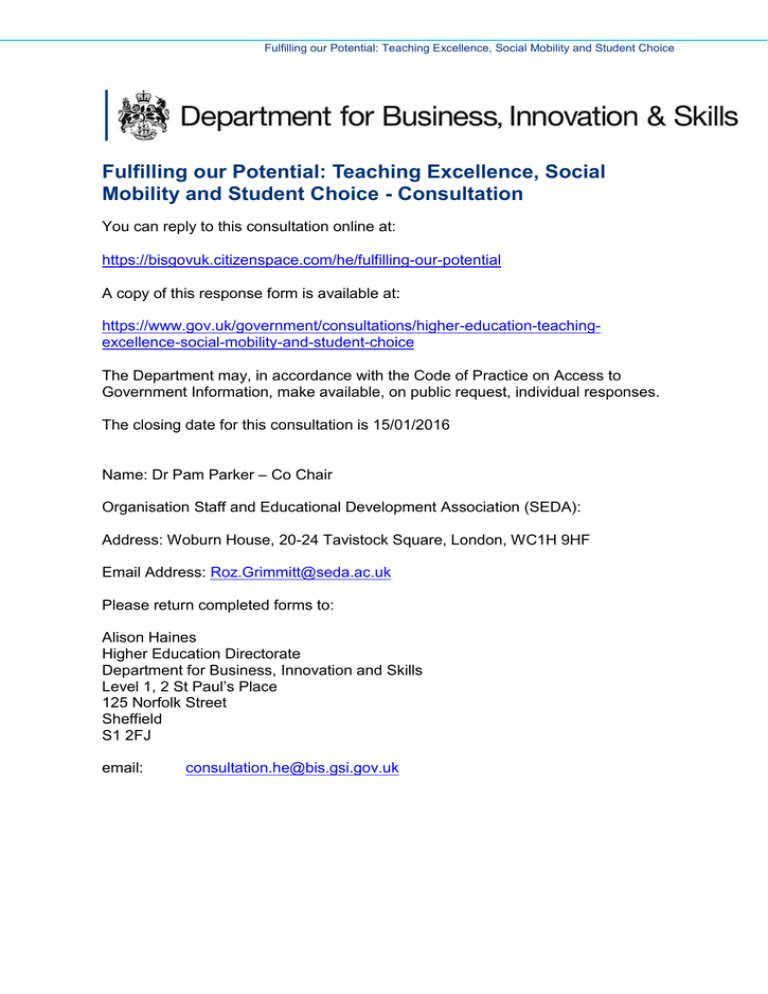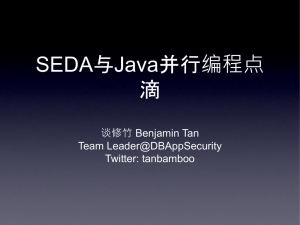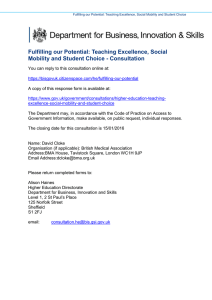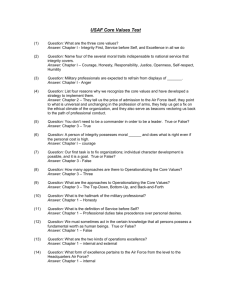Fulfilling our Potential: Teaching Excellence, Social Mobility and
advertisement

Fulfilling our Potential: Teaching Excellence, Social Mobility and Student Choice Fulfilling our Potential: Teaching Excellence, Social Mobility and Student Choice - Consultation You can reply to this consultation online at: https://bisgovuk.citizenspace.com/he/fulfilling-our-potential A copy of this response form is available at: https://www.gov.uk/government/consultations/higher-education-teachingexcellence-social-mobility-and-student-choice The Department may, in accordance with the Code of Practice on Access to Government Information, make available, on public request, individual responses. The closing date for this consultation is 15/01/2016 Name: Dr Pam Parker – Co Chair Organisation Staff and Educational Development Association (SEDA): Address: Woburn House, 20-24 Tavistock Square, London, WC1H 9HF Email Address: Roz.Grimmitt@seda.ac.uk Please return completed forms to: Alison Haines Higher Education Directorate Department for Business, Innovation and Skills Level 1, 2 St Paul’s Place 125 Norfolk Street Sheffield S1 2FJ email: consultation.he@bis.gsi.gov.uk Fulfilling our Potential: Teaching Excellence, Social Mobility and Student Choice Please tick the box that best describes you as a respondent to this consultation. Alternative higher education provider (with designated courses) Alternative higher education provider (no designated courses) Awarding organisation Business/Employer Central government Charity or social enterprise Further Education College Higher Education Institution Individual (Please describe any particular relevant interest; parent, student, teaching staff etc.) Legal representative Local Government √ Professional Body Representative Body Research Council Trade union or staff association Other (please describe) Public sector equality duty Question 1: a) What are your views on the potential equality impacts of the proposals and other plans in this consultation? We welcome the focus on improving social mobility for students from disadvantaged backgrounds and with protected characteristics. However, there is a lack of discussion in the green paper of the diverse range of students which gives the appearance that much of this is premised on the traditional young undergraduate student taking a three year full time programme. Others who need to be considered include mature students Fulfilling our Potential: Teaching Excellence, Social Mobility and Student Choice and those who also do not follow a traditional programme such as craft apprenticeship schemes and vocational programmes. In addition account needs to be taken of those existing higher education programmes that are different from this assumed norm due to this would include Foundation Degrees, further education in higher education provision and programmes in education, nursing and other health programmes. If we want Higher Education to change and to serve the needs of a wider society, these more diverse groups also need to be encouraged to be future students. There is also a need to explore different modes of study such as part-time, distance and blended learning all of which have increased over recent years. Whilst there is reference to students from BME backgrounds, and the needs of those in different economic and cultural contexts this is could be strengthened. There is already a national qualifications framework and we should be focusing on this and how all students can be given an opportunity to achieve access to education that enables them to succeed and achieve the outcomes of the appropriate level of that national qualifications framework. The focus should also not be just about access but should also be about support once the students have commenced their education. b) Are there any equality impacts that we have not considered? ☐ Yes ☐ No ☐ Not sure Please provide any further relevant evidence. We have indicated above some issues above. Teaching Excellence Framework (TEF) (Part A: Chapters 1-3) Question 2: How can information from the TEF be used to better inform student and employer decision making? Please quantify these benefits as far as you can. Whilst SEDA agrees with the need for better, more accurate and valid information for both student and employer decision making, the proposed measures within the TEF neither measure nor will distinguish ‘teaching excellence’. HESA already collects a wide range of data, some important elements of which (such as teaching qualifications of academics) it does not currently share publicly or shares in ways that make interpretation challenging. There would be merit in making this information more accessible and open. However, these data sets will also then be at the mercy of data aggregators and the media to manipulate and utilize as they see fit. This will inform students and employers but whether that information is good or not will be uncontrollable. Student satisfaction scores might well not equate to teaching excellence since context motivation and a number of other factors are in play here. It should be noted that universities have been focusing on employability for some time now and have made significant advances in this area but that the proposed data sets (e.g. DLHE) do not flag up context, etc to users and do not reflect enhancement work, carried out with the express aim of enhancing students’ life opportunities Transparent, direct and raw student comments/ratings and open text comments from programme leaders to respond, would allow a public and transparent dialogue that may offer Fulfilling our Potential: Teaching Excellence, Social Mobility and Student Choice some powerful insights as to the learning experience within a programme. This must be useful for prospective students. Question 3: Do you agree that the ambition for TEF should be that it is open to all HE providers, all disciplines, all modes of delivery and all levels? ☐ Yes ☐ No ☐ Not sure Please give reasons for your answers. We have provided responses to question 1 that provide our rationale for indicating Yes. A concern however is that if inappropriate data sets are used or data sets that are not fit for purpose, then universities will become more and more risk-averse, concentrating on the ‘tried and tested’ to try to ensure positive outcomes for the purposes of TEF, not for the furthering of knowledge, etc. We don’t want universities to become horribly ‘safe’ places and, if unmitigated, inappropriate data are used in a potentially damaging way, then this is a very probable outcome Question 4: Where relevant, should an approved Access Agreement be a prerequisite for a TEF award? What other mechanism might be used for different types of providers? Yes, an approved Access Agreement should ALWAYS be a pre-requisite for a TEF Award. Acknowledging through an Access Agreement, the steps that an HE provider would take to ensure they adhere to the Agreement, should be essential for any provider in receipt of student fees or public funding. Question 5: Do you agree with the proposals on: a) what would constitute a ‘successful’ QA review ☐ Yes ☐ No ☐ Not sure b) the incentives that should be open to alternative providers for the first year of the TEF ☐ Yes ☐ No ☐ Not sure c) the proposal to move to differentiated levels of TEF from year two? ☐ Yes ☐ No ☐ Not sure Please give reasons for your answer. The criteria outlined for a successful review are appropriate. In terms of the alternative providers we feel that there are many obstacles to these providers however this is not SEDA’s area of expertise. We have said yes to differentiated levels but have concerns about the suggestions of four levels which is felt to be a move towards an OfSTED-style approach Fulfilling our Potential: Teaching Excellence, Social Mobility and Student Choice and will lead to a hierarchy and ranking system and create competition which may not focus on what is intended. We believe that perhaps a two level approach could be used where all who have achieved the criteria gain TEF1 and then institutions apply for level 2 based on a specialism such as widening participation or a discipline approach. This is also likely to be easier for future students who are looking at how to make their choice of institution. Question 6: Do you agree with the proposed approach to TEF assessments on Timing? ☐ Yes ☐ No ☐ Not sure Assessment panels? ☐ Yes ☐ No ☐ Not sure ☐ No ☐ Not sure and process? ☐ Yes Please give reasons for your answer. If the sector is to transcend from its current peer-reviewed system of quality, that has a formulaic, bland and artificial experience and process to it to a transformational and transparent ‘real life’, ‘live’ and collegiate experience of quality assurance and more importantly enhancement, then many changes will be needed. Year 1 TEF metrics do nothing to tap into this more essential aspect of the enhancement of the learning and teaching experience and aspect of teaching excellence and professionalization where substantial progress has been made in recent years. This is a substantial omission in the quest for teaching excellence metrics. The TEF would need to expedite the use of live and transparent data sets instead of rooms filled with paper and files that a panel of experts must deem of the appropriate level. The issue in this proposal is that the data sets being proposed have questionable accuracy, are unstable and more importantly, are invalid as measures of teaching excellence, as proposed they would be invalid both in the timings, which need to reflect the length of degrees of between 1-3 years, and in the mode, where external panels members making judgements is unnecessary and will likely reduce innovation. It is also likely that such expert panels will do as they have done in past teaching quality exercises and, at considerable expense in time and effort, merely reinforce existing reputational measures. The Department for Business, Innovation and Skills may wish to look at the benefits in other models, such as self-review against published criteria and public data to lead collegiate engagements and inform a risk- based approach across multiple data sets, not just three that bias some institutions over others and lack connection to the desired teaching excellence (or preferably ‘learning excellence’). The intention must be to encourage innovation in the support of student learning and to promote diversity in the sector by encouraging institutions and programmes to focus upon and draw attention to their particular strengths. This is unlikely to occur within a system of peer review and simple, ‘one-size fits all’ metrics. Fulfilling our Potential: Teaching Excellence, Social Mobility and Student Choice Question 7: How can we minimise any administrative burdens on institutions? Please provide any evidence relating to the potential administrative costs and benefits to institutions of the proposals set out in this document. This is difficult to fully respond to with the limited detail of the proposals here. However we do feel that as staff are already over-burdened there should always be consideration of removing an activity that could be considered as creating a burden prior to adding further activities. Requiring staff to undertake further data collection removes them from the business of enhancing student learning. The lack of links between data is currently an issue across the sector and we would support the creation of a national government repository where all data could be accessed at one point. Any processes introduced should be reviewed first to ensure it is streamlined and effective. It would also be useful given the large amount of data collected currently to have some research undertaken on the data sets and their usefulness. Certainly data should not be gathered and then not used. For example, we would strongly encourage the publication of current HESA data on the teaching qualifications of HE staff as only the open publication of such data will encourage institutions to ensure it is accurate. Question 8: Do you agree with the proposed approach to differentiation and award as TEF develops over time? ☐ Yes ☐ No ☐ Not sure Please give reasons for your answer. There is very little evidence that the sector has sufficient variation to be able to differentiate in this way or to this extent. Neither would an Ofsted-styled scoring or approach be desired from our community, as autonomous institutions should have the ability and be expected to quality assure their own standards of teaching and learning experiences without regressing to an ‘accepted norm’ of teaching excellence, but instead an ‘assured variety’ of teaching specialisms and styles. This will be difficult with panel members as many may not fully appreciate the diversity of teaching excellence in subjects and contexts they may be unfamiliar with. There is a danger that the award of excellence in the tiers of the TEF will be a self-fulfilling prophesy: ie the historically well-funded HEIs with low staff student ratios, and students with high entry scores could be seen to be excellent without any sensitive exploration of what this means in terms of flexibility, diversity, response to different kinds of learners, disciplines and contexts. Building on the way that the TEF could differentiate, SEDA believe that a core level of award would be essential but instead of creating a four level differentiation, the sector may be better served by a two or three aspect differentiation to acknowledge institutional and subject specialisms that allow an additional differentiation. To differentiate on a subject/discipline basis makes complete sense but the suggestion of aggregating these individual scores to provide an institutional score does not. Question 9: Do you agree with the proposed approach to incentives for the different types of provider? ☐ Yes ☐ No ☐ Not sure Fulfilling our Potential: Teaching Excellence, Social Mobility and Student Choice Please give reasons for your answer. We have real concerns about the linking of fees with the TEF and feel strongly that this should not be the case. In terms of the incentives we believe that there is already complexity around much of the quality activities that all providers undertake and so whilst using the approach mentioned might support some of the diversity in provider we would urge consideration of something that is simple for all and already available. Question 10: Do you agree with the focus on teaching quality, learning environment, student outcomes and learning gain? ☐ Yes ☐ No ☐ Not sure Please give reasons for your answer. These are sensible and welcomed foci for this purpose but BIS will need to alleviate a concern that the student outcomes aren’t linked to the rate of taxation they will be paying in the future. SEDA are particularly keen that courses should never become categorised according to how much tax revenue they generate as that would remove one of the strengths of our Higher Education system. A graduate’s contribution to society is not measured in the size of their pay packet or tax return. Certainly such a measure is not even a proxy for the quality of their HE learning experience. There needs to be a balanced approach to teaching quality which takes account of inputs and effective processes as well as outputs. Learning environment should also be strengthened and more inclusively described within the paper as ‘appropriate’ learning environment. Teaching quality must be better defined. The changing nature of educational practice and metrics mean that current fads may not necessarily be a good indication of quality teaching, For example the current focus on class contact is not an indicator of teaching quality or a predictor of learning gain, what matters more is the time students spend ‘on task’ – a measure of engagement rather than contact. The emergent nature of much of the work on metrics means it is too premature to determine the value before this work has been concluded. Practice is far more nuanced and varied and the system should be prepared for that. Question 11: Do you agree with the proposed approach to the evidence used to make TEF assessments - common metrics derived from the national databases supported by evidence from the provider? ☐ Yes ☐ No ☐ Not sure Please give reasons for your answer. We are concerned that these metrics could damage student learning as much as improving it. Paragraph 9 page 32 states that “Excellent teaching has the ability to transform the lives of students” and these metrics do not measure the transformation only the output. There is no evidence that these metrics have brought about change to date? We acknowledge that there have been changes around assessment and feedback related to the National Student Survey data but beyond this there has been little change from these metrics. Students do not Fulfilling our Potential: Teaching Excellence, Social Mobility and Student Choice appear to be choosing their institution using these metrics, it is often parents that ask the questions around how many teaching hours rather than the students. The measures identified in paragraph 12 (page 33) are then noted in paragraph 13 (page 34) as being proxies rather than direct measures so there are concerns that this data is simply not robust enough. For example the DLHE prioritises those who leave and are in a high-earning graduate profession within 6 months of leaving HE. DLHE doesn’t take into account those who start up their own businesses, for example, or those who go into a graduate occupation, which is not high-earning, or at least not in the short term. The use of some metrics will promote certain institutions for the wrong reasons. The measures that should be considered should focus on learning gain and engagement. The HEFCE learning gain project will provide evidence in the future about what could be used but we recognise there is some time before the findings from this project will be available. There are however other measures that might be used and be more valuable such as the ASSIST Questionnaire and the NSSE. There needs to be a focus on work around Self Efficacy such as that of Mantz Yorke and work undertaken by the Centre for Recording Achievement. In addition accreditation by professional bodies e.g. BPS and NMC should be seen as a sign of quality, rather than relying solely on those suggested in the consultation paper. In terms of institutional data, paragraph 17 bullet point 5 does mention engaging teaching staff and training but this could be stronger in terms of emphasising the numbers of staff with teaching qualifications and professional fellowships such as those of the Higher Education Academy and the Staff and Educational Development Association that demonstrate engagement in supporting learning and teaching and educational development. Staff professional development around teaching is key. We recognise that the HESA data around these metrics is not robust but this is in part because there is insufficient importance placed on teaching as opposed to research and so it is not taken as seriously. The data will only become robust when there is a clear signal of the importance of this type of data and activity. Publishing the existing data on this would itself signal its importance and drive greater engagement with it. Social mobility and widening participation (Part A: Chapter 4) Question 12: a) Do you agree with the proposals to further improve access and success for students from disadvantaged backgrounds and black and minority ethnic (BME) backgrounds? ☐ Yes ☐ No ☐ Not sure Please give reasons for your answer. Much of this part of the paper was welcomed and strongly supported, although it is socially regressive that some universities are able to only accept A-levels. BIS should reflect on whether the entire sector should be more inclusive by recognising all nationally recognised and UCAS point awarding qualifications. We would also want to highlight that it is not just widening access, but recognising the additional resource implications if students from these groups (and others) are to really benefit from their time in HE. It is not just a ‘welcoming them in’ approach that is needed but Fulfilling our Potential: Teaching Excellence, Social Mobility and Student Choice a real enhancement of the learning environment in the light of their needs, etc once they are there. b) Do you agree that the Office for Students should have the power to set targets where providers are failing to make progress? ☐ Yes ☐ No ☐ Not sure Please give reasons for your answer. SEDA are in agreement that where institutions historic inability to progress the widening of access or inclusivity of the learning experience within their institutions, the OfS should be able to set targets (and create financial consequences) that ensure progress towards such axiometric ambitions is made. c) What other groups or measures should the Government consider? Engagement and adherence to: Race Relations Act, DDA and DSA. Question 13: a) What potential benefits for decision and policy making in relation to improving access might arise from additional data being available? b) What additional administrative burdens might this place on organisations? If additional costs are expected to be associated with this, please quantify them. We feel unable to respond to this question without more detail. The impact on administration cannot be assessed until more is known about the types of additional data that will be used. Opening up the sector to new providers (Part B: Chapter 1) Question 14: Do you agree with the proposed single route into the higher education sector? ☐ Yes ☐ No ☐ Not sure Please give reasons for your answer, including information quantifying how the potential cost of entry would change as a result of these proposals. Question 15: Fulfilling our Potential: Teaching Excellence, Social Mobility and Student Choice a) Do you agree with the proposed risk-based approach to eligibility for degree awarding powers (DAPs) and university title? ☐ Yes ☐ No ☐ Not sure Please give reasons for your answer. This is not an area of SEDA’s expertise. b) What are your views on the options identified for validation of courses delivered by providers who do not hold DAPs? This is not an area of SEDA’s expertise. Question 16: Do you agree with the proposed immediate actions intended to speed up entry? ☐ Yes ☐ No ☐ Not sure Please give reasons for your answer. This is not an area of SEDA’s expertise. Provider exit and student protection (Part B: Chapter 2) Question 17: Do you agree with the proposal to introduce a requirement for all providers to have contingency arrangements to support students in the event that their course cannot be completed? ☐ Yes ☐ No ☐ Not sure Please give reasons for your answer, including evidence on the costs and benefits associated with having a contingency plan in place? Please quantify these costs where possible. This should already be in place in institutions however this is not within SEDA’s expertise. Simplifying the higher education architecture (Part C) Question 18: a) Do you agree with the proposed changes to the higher education architecture? ☐ Yes ☐ No Please give reasons for your answer. ☐ Not sure Fulfilling our Potential: Teaching Excellence, Social Mobility and Student Choice Although there are understandable reasons for creating a superquango, this would include legislative changes to HEFCE which seem both unrealistic and unachievable in the timeframe. b) To what extent should the Office for Students (OfS) have the power to contract out its functions to separate bodies? ☐ Fully ☐ Partially ☐ Not at all c) If you agree, which functions should the OfS be able to contract out? d) What are your views on the proposed options for allocating Teaching Grant? Option 1: BIS Ministers set strategic priorities and BIS officials determine formula. ☐ Agree ☐ Disagree ☐ Not sure Option 2: BIS Minister sets strategic priorities and allocation responsibilities divested to OfS ☐ Agree ☐ Disagree ☐ Not sure Please give reasons for your answer, SEDA’s experience is allocation of grants requires an enormous amount of insight into the sector to be able to do this and so it does not make sense to move these away from those who have the existing experience Question 19: Do you agree with the proposal for a single, transparent and light touch regulatory framework for every higher education provider? ☐ Yes ☐ No ☐ Not sure Please give reasons for your answer, including how the proposed framework would change the burden on providers. Please quantify the benefits and/or costs where possible. This does not match the metric approach proposed and the focus on risk does not promote excellence. There is no mention in the paper of balancing the duty of the interests of the HEI’s as employers and their employees the teaching staff. There could be a risk of reputation and an incorrect perception of risk. There is also an issue about combining the Fulfilling our Potential: Teaching Excellence, Social Mobility and Student Choice funding and regulatory roles, so that there is no independent body with oversight of these roles. This would be a risk to the reputation of the Higher Education sector. Question 20: What steps could be taken to increase the transparency of student unions and strengthen unions’ accountability to their student members? Not SEDA’s area of expertise. Question 21: a) Do you agree with the proposed duties and powers of the Office for Students? ☐ Yes ☐ No ☐ Not sure Please give reasons for your answer. This is not SEDA’s area of expertise. b) Do you agree with the proposed subscription funding model? ☐ Yes ☐ No ☐ Not sure Please give reasons for your answer. This is not SEDA’s area of expertise. Question 22: a) Do you agree with the proposed powers for OfS and the Secretary of State to manage risk? ☐ Yes ☐ No ☐ Not sure Please give reasons for your answer. This is not SEDA’s area of expertise. b) What safeguards for providers should be considered to limit the use of such powers? Fulfilling our Potential: Teaching Excellence, Social Mobility and Student Choice Question 23: Do you agree with the proposed deregulatory measures? ☐ Yes ☐ No ☐ Not sure Please give reasons for your answer, including how the proposals would change the burden on providers. Please quantify the benefits and/or costs where possible. This is not SEDA’s area of expertise. Reducing complexity and bureaucracy in research funding (Part D) Question 24: In light of the proposed changes to the institutional framework for higher education, and the forthcoming Nurse Review, what are your views on the future design of the institutional research landscape? This is not SEDA’s area of expertise. Question 25: a) What safeguards would you want to see in place in the event that dual funding was operated within a single organisation? This is not SEDA’s area of expertise. b) Would you favour a degree of hypothecation to ensure that dual funding streams, along with their distinctive characteristics, could not be changed by that organisation? ☐ Yes ☐ No ☐ Not sure Please give reasons for your answer This is not SEDA’s area of expertise. Question 26: What are the benefits of the REF to a) your institution and b) to the wider sector? How can we ensure they are preserved? Maintaining an important connection between Research and Learning and Teaching experiences of students should be a benefit to both institutions and the wider sector. Question 27: How would you suggest the burden of REF exercises is reduced? This is not SEDA’s area of expertise. Fulfilling our Potential: Teaching Excellence, Social Mobility and Student Choice Question 28: How could the data infrastructure underpinning research information management be improved? This is not SEDA’s area of expertise. Do you have any other comments that might aid the consultation process as a whole? Please use this space for any general comments that you may have, comments on the layout of this consultation would also be welcomed. SEDA’s core objective is the advancement of education for the benefit of the public and key to this is the improvement of educational and professional development in Higher Education. This is in order to enhance the quality of student educational experiences. We are therefore supportive and encouraged by the intention of the TEF to raise the status of teaching. The potential of the TEF will be a positive move in challenging practice and the potential to help prospective students reach decisions. The focus on widening participation is clearly very positive as are the statements that context will be taken into account and, that comparisons around discipline will be included. It is clear that there is an understanding that there are some practices in Higher Education that do need challenging and addressing to ensure the students experience are enhanced however, there also needs to be recognition that there are already many areas of teaching excellence and this balance does not come across. We welcome the recognition of the wider aspects of teaching excellence with the inclusion of the environment and learning gain. We believe that anything intended to enhance the student experience is to be supported in principle, however we do have several significant concerns about the proposals as they stand. ● The use of the three core metrics which do not focus on the transformation of the student and their learning gain is of great concern. ● The focus on teaching excellence without a definition of that term raises issues around what is being measured across the sector. ● The four tiers of TEF suggest a move towards an inappropriate Ofsted-style approach. ● It is not clear whether this this about institutional, discipline, programme or individual teaching excellence. ● We cannot have confidence in a framework around teaching excellence that has no metrics for the professionalization of teaching , such a framework will not be able to raise the status of teaching to equal that of research where there are known metrics around three star and four star research. ● It takes time to build a reputation and there is no real acknowledgement of this in the timescales proposed. We believe that if there is a panel of experts this should be formed of those in the position of being able to judge teaching. This should include both experts who prepare teaching staff but also those at the “coal face” who deliver excellent teaching. There is already a strong network of National Teaching Fellows and Principal Fellows of the Higher Education Academy and these two network would be an important source of panel members. We are supportive of a move to raise the status of teaching and student learning but the definition of metrics needs far more development and we are in a position as a community to work with others in that development. This is the beginning of an important journey and it is important Fulfilling our Potential: Teaching Excellence, Social Mobility and Student Choice that it sets off from the correct starting point utilising as much sector knowledge as possible. SEDA would be happy to provide further advice to BIS on these matters and be involved in any work around metrics. Thank you for your views on this consultation. Thank you for taking the time to let us have your views. We do not intend to acknowledge receipt of individual responses unless you tick the box below. Please acknowledge this reply ☒ At BIS we carry out our research on many different topics and consultations. As your views are valuable to us, would it be okay if we were to contact you again from time to time either for research or to send through consultation documents? ☒Yes BIS/15/623/RF ☐ No




